Film is powerful. But to have the strongest impact it needs to be used in the right way and seen by the right people. That's why thinking about distribution needs to be a key part of youth video projects.
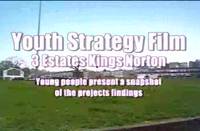 A great video about the challenges young people face in a local area, that is never seen by those who are responsible for the decisions that could improve things, is an opportunity missed. Identifying who should see your video, and inviting them to watch and respond to it, is an important part of any change-making video project*.
A great video about the challenges young people face in a local area, that is never seen by those who are responsible for the decisions that could improve things, is an opportunity missed. Identifying who should see your video, and inviting them to watch and respond to it, is an important part of any change-making video project*.
A lot of videos miss getting the audience they deserve. Social media and online distribution have a big role to play here. Beth Kanter has remixed a version of the Social Media Game for Documentary Film Makers. The social media game can provide a great starting point for exploring the opportunities presented by new technologies for reaching wider audiences.
Distribution in action:
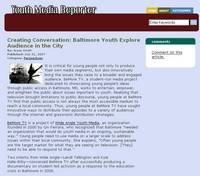 As I was preparing this post I came across this story from Youth Media Reporter which shares an account of how young film makers in Baltimore made sure their work was well distributed and created conversation. The group realised their their videos, shown on local Public Access TV were not getting enough viewers, so they turned to the Internet and social networking sites to build a bigger audience.
As I was preparing this post I came across this story from Youth Media Reporter which shares an account of how young film makers in Baltimore made sure their work was well distributed and created conversation. The group realised their their videos, shown on local Public Access TV were not getting enough viewers, so they turned to the Internet and social networking sites to build a bigger audience.
But, as well as sharing video online, the group looked to showings in the local community, and have created their own do-it-yourself distribution guide including a focus on community screenings. A short quote:
Montebon explains the importance of community screenings in this new approach: “The reason for a screening is, you can [sit at home and] watch something on TV… but it takes another step to have a type of forum. I think what the community screenings are supposed to serve, is a platform where people can start a sort of discourse.†Airing a youth-made TV episode in a community context, such as a public park, museum, or neighborhood event, creates a potential for dialogue. It is easier for people to talk to one another about youth-led issues in a group setting, as well as engage with youth media makers on the issues they raise.
How do you make sure your video projects start conversations and create change?
Not just video:
If a video has been created to lobby for change (for example, to get a local authority to provide cycle lanes on a route to school, or to call on a local leisure company to make their activities affortable to all young people) then it is also worth thinking carefully about other tools that will be needed to create change. A video is one of the most effective tools for getting decision makers to understand a problem – but will everyone who is in the meeting that makes the decision you want to influence have seen the video? And have you provided a clear proposal along with your video stating in words what you want changed?
————
*I don't want to suggest that all video projects have to be externally focussed. All art-froms can be effective tools for individual and group learning as an end in itself. However, where a change making impact is within reach, then I would always encourage its pursuit…

 That can make it rather tricky to make an informed decision on responding to a planning application.
That can make it rather tricky to make an informed decision on responding to a planning application.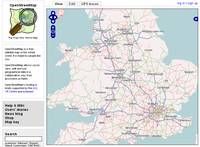 So whilst we've got access to a growing number of free-to-use tools for
So whilst we've got access to a growing number of free-to-use tools for 
 The challenge from day 13 is to
The challenge from day 13 is to 
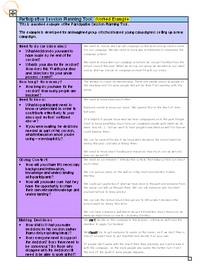
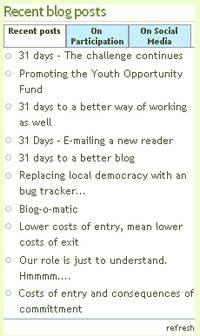 thinking on technology, youth participation and social change – the audiences interested in those elements are often quite distinct. I had thought about a 'posts on participation' and 'posts on technology' block for the side-bar, but felt that would be too cluttered… however, thanks to the
thinking on technology, youth participation and social change – the audiences interested in those elements are often quite distinct. I had thought about a 'posts on participation' and 'posts on technology' block for the side-bar, but felt that would be too cluttered… however, thanks to the 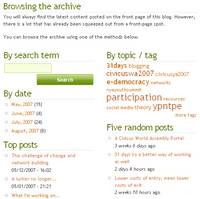 As the archive block has moved further down the page in the re-shuffle, I've also added a new
As the archive block has moved further down the page in the re-shuffle, I've also added a new 
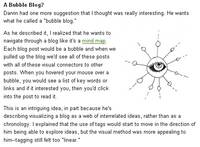 One I've been particularly struggling with is a 1/2 finished post on visualisations. Particularly on ways of taking RSS feeds and managing the information in more visual ways (perhaps in mind-mapped ways like the
One I've been particularly struggling with is a 1/2 finished post on visualisations. Particularly on ways of taking RSS feeds and managing the information in more visual ways (perhaps in mind-mapped ways like the  I'm interested in whether the 31-day-challenge approach could be adopted for organisational learning and change programmes (I'm going to be supporting a number of organisations on learning journeys to engage with social media this autumn) – but I'm worried that this current challenge eats up too much time to fit easily into the work day of busy teams.
I'm interested in whether the 31-day-challenge approach could be adopted for organisational learning and change programmes (I'm going to be supporting a number of organisations on learning journeys to engage with social media this autumn) – but I'm worried that this current challenge eats up too much time to fit easily into the work day of busy teams.